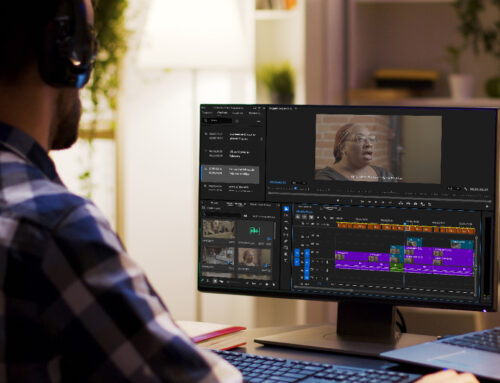First Impressions are Important
We have all heard some variation of the phrase, “Your first impression is your last impression.” Though an age-old expression, it is more important than ever in this time of social media and diminishing attention spans to take measures to secure a good first impression.

Scientific research supports this notion. In 2006, Princeton psychologists Janine Willis and Alexander Todorov conducted a series of experiments that revealed that when observing a stranger’s face, it only takes a tenth of a second to form an impression of them. Even more fascinating was the fact that longer exposure times did not result in a significant departure from that initial impression, meaning that our instantaneous judgments are often the final opinions we will have of a stranger’s character. This is especially true when a first impression is negative, which further research in this area has revealed is much harder than a positive impression to reverse over time.
In our digital age, first interactions increasingly happen online rather than in person. One of the most common ways that we form impressions of others online is based on their profile picture. Without the ability to assess someone face to face, a picture is your first line of defense in showcasing yourself to be competent, professional, and friendly.

Many assume that as long as they use a photo of themselves online that they personally like, the photo will be acceptable to others. While this might work for more casual settings, your forward-facing portrait should be beyond the quality of a phone selfie in the world of business, law, and government. In the professional space, the profile photo at the top of your page is at the frontline of what many call your personal brand. It is the first page of the story you tell about your professional self. And although many might have a general idea what their personal brand is and how it can be best portrayed, there are various elements of good photography such as lighting, pose, color composition, and location, that must be properly accounted for.
Think of featured images in a National Geographic magazine and how the photographers are able to capture the wonder and beauty of the natural world and the people in it. This strategic expression is not only limited to nature and street photography but is just as vital to a quality headshot. This is the reason why a having professional headshot is so important and should be taken just as seriously as your logo, business cards, or website.
The Art of the Professional Headshot
 When a headshot is taken professionally, such as this photo Circuit Media took of Colorado Attorney General Phil Weiser, there is an immediate air of legitimacy the viewer ascribes to the subject. This sort of representation has immediately quantifiable benefits; for instance, LinkedIn profiles with professional headshots get 14 times more profile views than those without professional headshots. Beyond that, this photo portrays the quality of trustworthiness, which is essential for those like Phil who hold public office, but also for anyone who is trying to expand their network of clients and associates.
When a headshot is taken professionally, such as this photo Circuit Media took of Colorado Attorney General Phil Weiser, there is an immediate air of legitimacy the viewer ascribes to the subject. This sort of representation has immediately quantifiable benefits; for instance, LinkedIn profiles with professional headshots get 14 times more profile views than those without professional headshots. Beyond that, this photo portrays the quality of trustworthiness, which is essential for those like Phil who hold public office, but also for anyone who is trying to expand their network of clients and associates.
On the technical side, this photograph illustrates what makes for a high-quality headshot. Well-placed and reflected lights introduce dimension to the face when done correctly and help to separate the subject from the background. It is also important to keep the person as the main focus in the portrait, which is most easily achieved by using a solid color backdrop. Glasses add another level of difficulty to taking photos with a flash, but it is not impossible to execute. The light was placed slightly higher than it would usually and used to illuminate his highest features, with a reflector filling the shadows left below. This method is known as clamshell lighting and is a well used technique in headshot photography. Overall, Phil’s photograph is an example of what is most traditionally viewed as a professional headshot and is a style that cannot steer you wrong.

Of course, getting a headshot done professionally does not necessarily mean it must be done in a studio. In fact, many businesses are beginning to favor more interesting backdrops, in order to showcase their office or their city’s unique qualities. This photograph, taken at Union Station, has the same professional dress and attention that Phil Weiser’s studio portrait did, but creates a more industrial look and feel through its backdrop of train tracks and an intricately designed structure. By utilizing a shallow depth of field and angling the backdrop to create leading lines toward the subject, we are not distracted, despite the complex arrangement of pillars behind her. The lines in the structure all lead to one large line in the middle, which in turn leads the viewer’s eyes straight to the smile on the woman’s face.
Marketing and Branding for Your Company
Along with an individual headshot, there could also be a need for further representation of your business and you. For example, imagine your company, firm, or agency sends out a press release regarding an important development, is launching a new marketing campaign or is featured in a magazine or newspaper. In each of these cases, additional photos of your team and you will be valuable.
Given the ever-expanding readership of print and digital media, along with the Internet’s 2.1 billion social media users sharing and reposting such media, any number of people could end up seeing these photos. It is for this reason that one should consider, in addition to your individual headshot, requesting additional company photos that will positively represent your brand wherever your photographic presence may travel. 
To better illustrate this style of photo, consider this picture we took for our in-house publication, Law Week Colorado. Our photographer framed the subjects within their office space, creating an environmental portrait meant to portray the company leaders in a manner more interesting than a side-by-side, close-up photograph. By having the subjects in a relaxed, sit-down pose with genuine smiles, and using the natural lighting of the space, the photograph portrays a more casual presence while also maintaining the right amount of professionalism. This example does well to illustrate the fact that professional photographs do not necessarily need to be rigid and serious.

Along those same lines, Denver Trial Lawyers requested professional photographs for marketing and press purposes, specifically for an ad celebrating their law firm’s recent achievements. This celebratory photo was taken in a local bar. With their hearty smiles and drinks in hand, this photograph gives off the impression that times are indeed good for their firm. It is decidedly a far cry from the purposely simple, serious headshots one typically associates with a white collar industry, but nevertheless serves the purpose of expanding upon these individuals’ personal brand and the digital story they tell of themselves in a fun, yet classy, way. Finding this balance is tricky, which is why it is so important to work with a proven, professional photographer. By working with a professional, Denver Trial Lawyers achieved a representation of individuals who you would trust as your lawyers, but with whom you would also grab a drink.
Who Shapes a Photograph?

A photograph is not the same as looking in the mirror — the image can be melded and modified in many different directions. For example, in a Canon ad from 2015, six different photographers are told six different backstories about the same man. Basing their styles on these backstories, the photographers end up taking six completely different photographs. The ad ends with the conclusion that “a photograph is shaped more by the person behind the camera than by what is in front of it,” a statement that encompasses both style and the audience’s impression. No matter what the subject intends to convey when taking his or her own photo, there exist the many factors discussed above, which ultimately dictate what impression your photo will make. Thus, when deciding who to trust with taking your headshot, wouldn’t you want to make sure to select someone who knows the tricks of the trade?
Here at Circuit Media, we take pride in our ability to shape our client’s professional photographs to meet their needs. Through our experience and technical skills, we ensure a positive first impression with whomever may encounter your image, be it on social media, your website, an ad in our publication, Law Week Colorado, or wherever your photo may travel.
Interested in our photography services? To learn more, email [email protected] or call (303) 292-1212.




